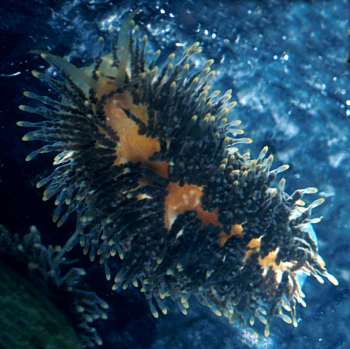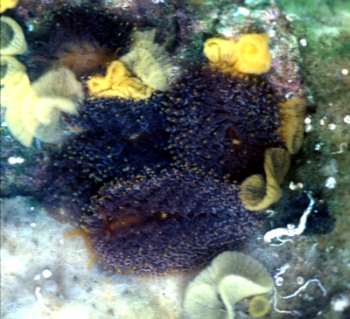

Phestilla panamica
Rudman, 1982
Order: NUDIBRANCHIA
Suborder: AEOLIDINA
Family: Tergipedidae
DISTRIBUTION
Pacific coast of Panama.
PHOTO
Saboga Island, Pearl Island Group, Bay of Panama. Lower photo showing group of animals and egg ribbons clustered on a colony of Porites lobata. Photos: R. Highsmith.
The body, oral veil and oral tentacles are a translucent orange, with a few white patches visible on the dorsum. The head region is developed into a wide rounded oral veil, with a pair of smooth tapering oral tentacles arising some distance in from the edge. The foot is transclucent, wider than body and rounded anteriorly. Posteriorly, the foot is only slightly longer than the body. The rhinophores are smooth, tapering distally to a rounded tip. The cerata appear dark grey-brown with white patching and a distinct yellow tip. The yellow tip originates from epithelial pigmentation while the brown colour comes from the digestive diverticulum. The ceratal epithelium is translucent with some white patching and a distinct thin white band around the cerata just below the sub-terminal neck at the distal end. The cerata are arranged in transverse rows, each row on a distinctly raised ridge. There are 3-5 rows on each side in front of the pericardium, and 8 rows on each side behind the pericardium, with up to 18 cerata in a row. Each ceras is long and cylindrical with a rounded bulbous tip and a narrower neck. Largest preserved animal was 24 mm long.
Phestilla panamica has many similarities to Phestilla lugubris in external appearance and general morphology, and both grow to a similar size. The major difference between the two species, other than a slight difference in penial morphology, is the shape of the radular teeth. In P. lugubris each tooth has five or six large denticles on each side of the central cusp. [see radula of coral-feeders]. The cusp always further forward than the denticles while in P. panamica there can be up to ten denticles on each side and the central cusp is shorter than the denticles [see message #12287 for radula of P. panamica]. Specimens of P. lugubris I have examined from East Africa, Indonesia and Australia show no difference in tooth morphology. In similar sized animals, P. panamica has more teeth in the radular ribbon than P. lugubris. Two 24 mm long preserved animals of P. panamica had 46 and 52 teeth while a 25 mm long preserved specimen of P. lugubris had only 33 teeth. The largest number of teeth I have counted in P. lugubris was 39 in a 42 mm long live animal.
This is the first record of the genus and of a coral-feeding nudibranch outside the lndo-West Pacific faunal region. The collector, Dr R. Highsmith, found it associated with the coral Porites lobata, on which it lives and feeds. Usually it lives in depressions and cavities on the underside of coral colonies during the day. Its eggs ribbons are deposited on or near the coral. They are similar to those of Phestilla lugubris and range in colour from bright yellow, when recently laid, to white.
-
Rudman, W.B. (1982) A new species of Phestilla; the first record of a corallivorous aeolid nudibranch from tropical America. Journal of Zoology, London, 198: 465-471.
Rudman, W.B., 2005 (February 8) Phestilla panamica Rudman, 1982. [In] Sea Slug Forum. Australian Museum, Sydney. Available from http://www.seaslugforum.net/factsheet/phespana
Related messages
-
Radula of Phestilla panamica
From: Bill Rudman, February 11, 2005 -
Is Phestilla panamica a good species?
From: Bill Rudman, February 11, 2005
